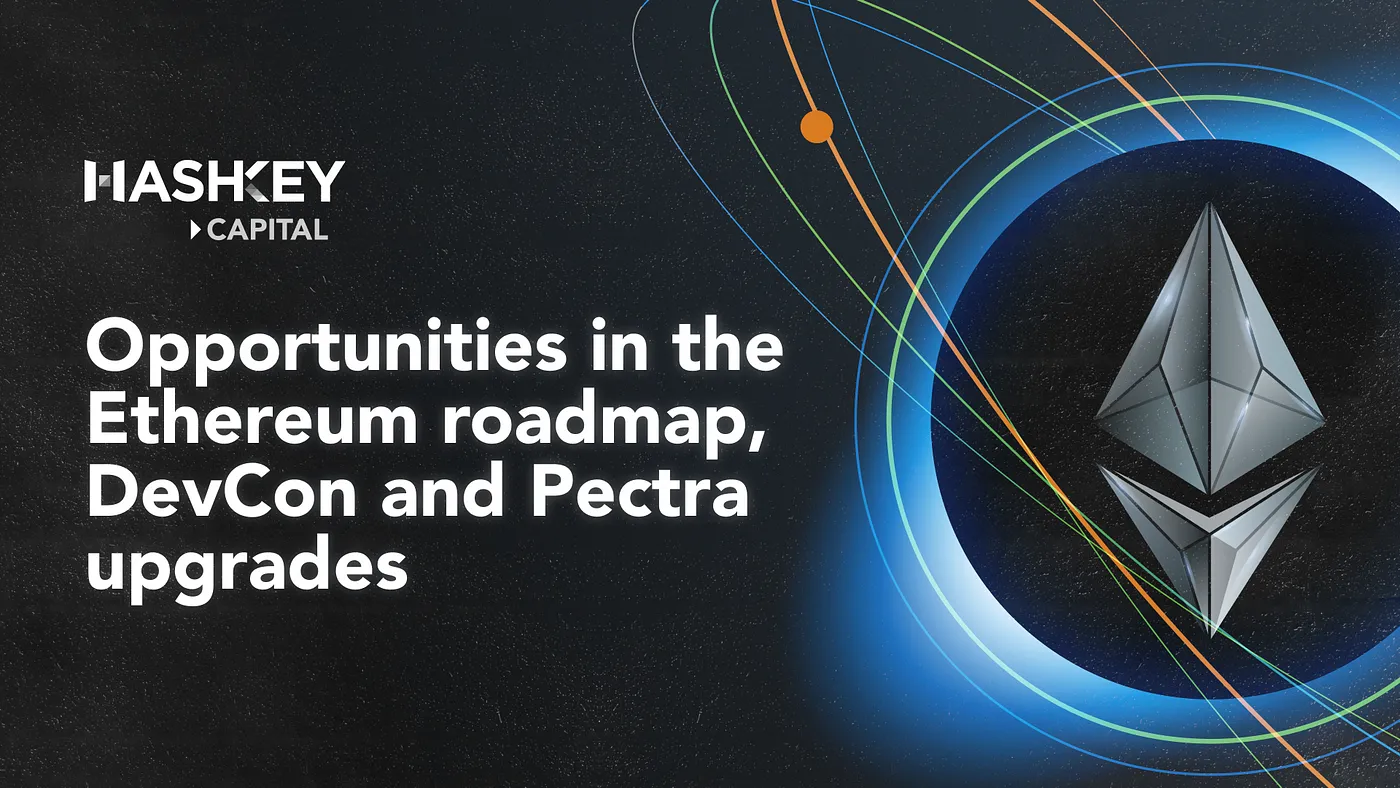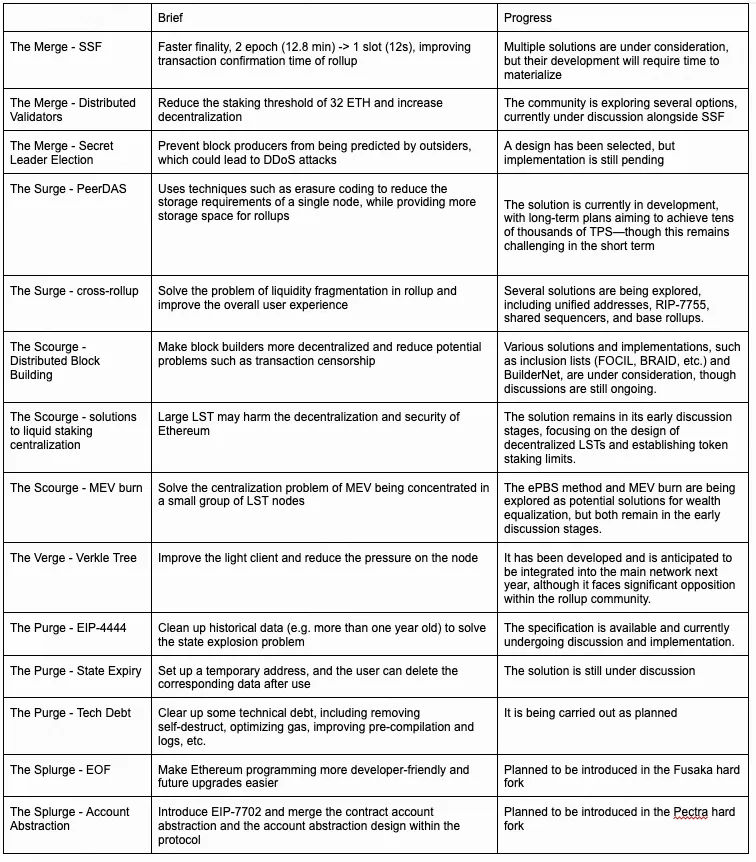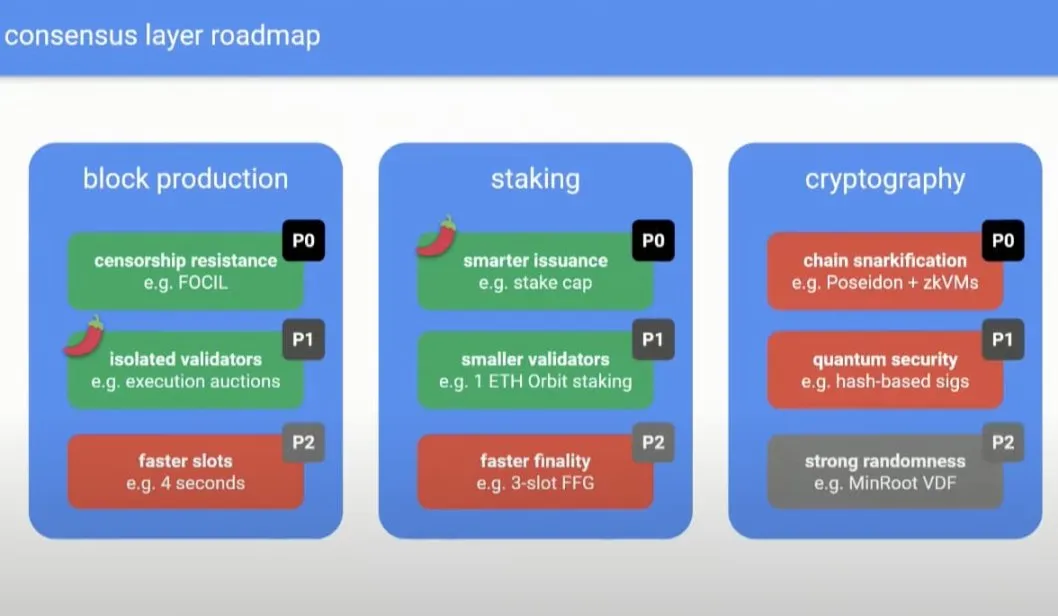Author: HashKey Capital
Compiled by: Vernacular Blockchain

Looking back, many cutting-edge discussions in the Ethereum developer community have profoundly influenced the daily applications we take for granted today, such as decentralized exchanges (DEXs), lending platforms, Rollups, and decentralized applications (dApps). These discussions often also hint at future investment opportunities.
As we head into 2025, what signals can we take from Ethereum’s roadmap, the recent DevCon conference, and the upcoming Pectra upgrade? Let’s take a look.
1. Ethereum’s roadmap: a guide for future development
Ethereum’s roadmap has always been an important reference for observing future development directions, and its key milestones include The Merge, The Surge, The Scourge, The Verge, The Purge, and The Splurge. These stages show the path of Ethereum’s continuous evolution:
The Merge: This phase focuses on the combination of the execution layer and the consensus layer, completing the transition from PoW to PoS. It also includes some improvements to the consensus protocol, such as Single-Slot Finality and lowering the threshold for validators.
The Surge: The core discussion revolves around future scalability improvements and underlying optimizations to better support Rollups. Among them, EIP-4844 has been launched, and upcoming key features include PeerDAS (reducing node pressure) and cross-Rollup interaction capabilities.
The Scourge: Mainly solves some problems related to MEV, such as the over-centralization of builders and the phenomenon that the value of MEV is captured by large liquid pledge tokens (LST).
The Verge (upgrade phase): The underlying layer is converted from Merkle tree to Verkle tree, and the zero-knowledge nature of EVM is promoted (Snarkify).
The Purge: Reduce the storage and state maintenance pressure of Ethereum nodes by deleting or archiving historical data, while cleaning up some technical debt.
The Splurge (optimization phase): includes some more cutting-edge improvements, such as EVM underlying optimization, account abstraction, and the application of other cryptographic technologies (such as VDF).
The table below summarizes the key improvements in each phase, highlighting their main impact and current progress.
By combing through these milestones, it is not difficult to see that Ethereum’s roadmap is not only a plan for technological evolution, but also an important guide for the future development of the entire ecosystem. It not only provides a clear direction for developers, but also reveals potential opportunities for investors.

2. DevCon
Another interesting source of insight is the recent Ethereum DevCon conference, where developers and community members came together to discuss key challenges and explore innovative solutions.
One of the highlights was Beam Chain, a technology that was half-jokingly but aptly called "Ethereum 3.0". The name reflects the community's enthusiasm for exploring new directions. Beam Chain introduces some fundamental improvements, such as advances in Snark technology, block generation, and optimization of the staking mechanism. However, since its roadmap spans about five years, it is more of a long-term vision than a short-term focus.

https://www.youtube.com/watch?v=Gjuenkv1zrw
3. Rollup-related topics are at the core of the DevCon conference
At the DevCon conference, Rollup-related topics became the focus, with liquidity fragmentation and Rollup interoperability being considered key issues affecting user experience. Many keynote speeches and panel discussions focused on potential solutions to these challenges. The conference also delved into the technical maturity of Layer 2 (L2) solutions. Currently, only Optimism and Arbitrum have reached stage 1 (permitted fraud proof), while most other L2 projects are still at stage zero (centralized upgrade, no fraud proof) and need to align with the upgrade of Layer 1 (L1) to make progress.
The meeting also discussed chain abstraction, pre-confirmation mechanisms, cryptographic applications, and future upgrade plans. The upcoming Pectra upgrade is expected to play a key role in solving these problems, which will be described in detail in the next section.
4. Pectra Upgrade
The Pectra upgrade mainly belongs to The Surge phase, as its core goal is to improve scalability (such as increasing Blobs) and optimize the use of Rollups. At the same time, it also promotes account abstraction and innovative features in The Splurge phase. This upgrade also partially involves storage optimization and cryptographic improvements in The Purge and The Verge.
Therefore, the Pectra upgrade is a comprehensive technology update with multiple phased goals, but its focus is on scalability (The Surge) and innovation (The Splurge).
Currently, the Ethereum Pectra upgrade is scheduled to be completed in the first quarter of 2025, and will introduce a number of important changes covering multiple aspects from the underlying architecture to the end-user experience. 1) EIP-7702: Account Abstraction (AA) One of the most user-friendly features in the Pectra upgrade is EIP-7702. The proposal is based on the concepts of EIP-3074 and EIP-4337, allowing all external accounts (EOAs) to be temporarily converted to smart contract accounts. This upgrade will simplify the user experience, such as implementing single-signature multi-transaction processing and zero gas fee functions. However, this may also introduce certain security risks, such as signature phishing. Therefore, wallets and related products need to be upgraded accordingly to adapt to this change. Overall, EIP-7702 is expected to provide great opportunities for account abstraction projects. For more details, please refer to our related report. 2) EIP-7691: Increase the number of blobs The Pectra upgrade will adjust the number of blobs per block, increasing the target value from 3 to 6 and the maximum value from 6 to 9. Blob provides a more economical way to store Rollup. This improvement will reduce the cost of Rollup and increase the competitiveness of Ethereum decentralized applications (dApp). Although this change will slightly increase the operating cost of the node, it will significantly improve storage efficiency, bringing greater advantages to Rollup. In addition, this adjustment will also achieve faster gas fee decreases (when Blob is not in use) and slower gas fee increases (when Blob reaches full capacity). 3) EIP-7251: Increase the staking limit The Pectra upgrade also increases Ethereum's staking limit from 32 ETH to 2,048 ETH. This change allows staking service providers and large holders (whales) to merge their ETH into a single node, thereby reducing the number of validators and improving the efficiency of the staking process.
The Pectra upgrade not only represents an important technological breakthrough for Ethereum, but also demonstrates its all-round improvement in user experience, scalability, and efficiency, injecting more potential into the future development of the ecosystem.
5. Future opportunities
The continued technological progress and research discussions in the Ethereum ecosystem bring exciting possibilities for its future development. Here are some key opportunities to shape the future. 1) Interoperability between Rollups A recurring theme in the Ethereum roadmap and DevCon discussions is enhancing liquidity and interoperability between Layer 2 (L2) Rollups. Solving these issues is critical to improving user experience and scaling Ethereum.
Solutions currently under development:
Layer 1-based Rollup: Currently, many L2s use a centralized sequencer to sort transactions and publish them to Layer 1 (L1), which limits timely interactions between L2s. A proposed solution is to use L1 as a sorting layer, thereby ensuring atomic interactions between L2s using this approach.
Shared sorters: Another approach is for multiple L2s to share a common set of sorters, facilitating seamless interactions and reducing liquidity fragmentation.
Cross-Chain Intents: In addition to the sequencer, cross-chain intents allow developers to solve interoperability problems at a higher level and support coordinated interactions between Rollups.
Progress and Key Players: The Ethereum community is actively developing and testing solutions to these challenges:
Spire Labs' Based Stack: Designed specifically for L1-based Rollups, expected to go live in the first quarter of 2025.
Shared sequencer projects: Platforms such as Astria, Espresso, and Polygon AggLayer are iterating on the shared sequencer model.
ERC Standards:
ERC-7683: Supported by Unichain, Arbitrum, etc., it aims to solve the cross-chain liquidity problem.
Optimism's ERC-7802: Introduced SuperchainERC20, providing a unified asset standard within the Superchain ecosystem and facilitating liquidity transfer.
As these solutions evolve, they may compete for dominance in 2025, reshaping Rollup interoperability and Ethereum's scalability. 2) Account Abstraction (AA) The activation of EIP-7702 will affect all external account (EOA) addresses, creating significant opportunities for account abstraction (AA) projects. Combined with advances in chain abstraction, intent, and related technologies, EIP-7702 is expected to promote the development of more complex cross-chain and multi-chain interaction functions.
However, the AA track is at a critical juncture, after the market performance of standards such as ERC-4337 was not satisfactory. The upcoming Pectra upgrade in the first quarter of 2025 may be the last major opportunity for the AA ecosystem to achieve product-market fit. Teams like Zerodev that are the first to adopt EIP-7702 are expected to take full advantage of this upgrade and may usher in significant growth. The results of the future will soon be apparent. 3) Cryptography Applications Cryptography has always been at the core of the Ethereum roadmap and DevCon discussions, and its progress is paving the way for breakthrough technologies and applications.
Technical level: Frameworks such as zkEVM and zkVM are maturing, and combined with the application of technologies such as zero-knowledge proof (ZKP), multi-party computation (MPC) and fully homomorphic encryption (FHE), they show the potential for innovation. The DevCon discussion specifically mentioned cutting-edge technologies such as indistinguishable obfuscation (iO), which is known as the "crown jewel" of cryptography and may receive more attention in the near future.
Consumer side: Cryptographic advances hold great potential. For example, applications such as ZK Email (represented by the Aztec Noir implementation) and zkTLS may be more widely adopted, providing users with greater security and privacy protection. In addition, the recent dismissal of OFAC sanctions against Tornado Cash has alleviated compliance concerns about privacy technologies to some extent, which may accelerate the acceptance and use of these technologies in real-world applications.













